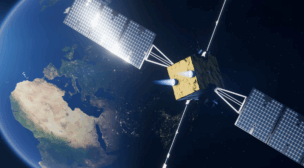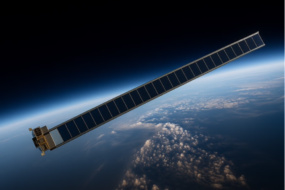It’s hard to sum up the state of ISAM in one overarching statement. As an industry term, it’s a bit like three kids in a trench coat trying to pass as a single individual—fittingly, no one part is mature enough to stand on its own.
Companies working on in-space servicing, assembly, and manufacturing are at vastly different stages in their development. Some activities, such as commercial rendezvous and proximity operations (RPO) necessary for satellite life extension and deorbit missions, have been demonstrating their capabilities on orbit for years. Other innovations, such as reliably getting goods manufactured in space shipped back to Earth, have only just come online.
“I do think we’ve done ourselves a disservice, a little bit, by putting servicing and assembly and manufacturing into one acronym,” Greg Richardson, executive director of the Consortium for Space Mobility and ISAM Capabilities (COSMIC), told Payload. “They are different types of missions with a different spectrum for when they might become available, or when they might be most useful.”
Even in areas where companies proved the tech works, demand has been slow to fully materialize. In multiple conversations with industry leaders, however, there’s a resounding sense of optimism for the future—lower launch costs, and the projected volume of new hardware being sent to space, have ISAM companies confident that their commercial success is just around the corner.
The Service Economy
In-space servicing covers many activities, including life-extension missions, orbital transfer services, refueling, and on-orbit repairs. For the most part, the tech to fly these missions has been demonstrated.
- Astroscale’s ELSA-d and ADRAS-J missions proved the company’s ability to perform RPO tasks, by demoing its magnetic capture system and closely inspecting a rocket body. Astroscale is planning another mission to launch next year, ELSA-M, which aims to deorbit a Eutelsat OneWeb sat.
- SpaceLogistics, a Northrop Grumman subsidiary, launched two life-extension missions in 2020 and 2021 to raise the orbit of two Intelsat comms satellites in GEO, extending their lifespans by 15+ years. The company is also planning another life-extension mission using its Mission Robotic Vehicle to provide three GEO sats with Mission Extension Pods—jet packs to increase their lifespans.
- Other companies, including D-Orbit, Exotrail, and Impulse Space, have collectively flown multiple orbital transfer missions, by towing satellites to their preferred trajectories.
“It is the beginning, I think, of a really exciting time for robots in space,” Bo Naasz, NASA’s ISAM and RPO lead, said. “We are evolving…to actual commercial customers that are being serviced affordably by commercial services. That’s a huge transition that I believe is happening.”
The recent influx of companies flying RPO missions and demonstrating life extension services shows these pieces of the ISAM puzzle might be the most commercially mature.
Orbit Fab, the CO-based in-space refueling company, has already sold over 50 of its RAFTI fueling ports, which will enable refueling services in space as soon as next year, according to Manny Shar, the company’s chief strategy officer. Once Orbit Fab completes its first in-space refueling mission with the Defense Innovation Unit (DIU) targeted for early 2026, demand is expected to compound.
“The response that we’ve had from the commercial side tends to be…‘Once you prove it, we will come knocking down your door’,” Shar said.
Kall Morris Inc., a MI-based startup working on a satellite-capture system initially billed for debris removal missions, first demoed its grapple-tech aboard the ISS after a launch at the end of last year. KMI has since fielded requests to provide a number of other services, including end-of-life deorbit services, orbital transfers, and potentially—further down the line—in-space manufacturing missions.
“My nervousness now is not, is there a market? Are we going to have a future? My nervousness is: Can we supply that market?” Adam Kall, KMI’s cofounder and director of science, told Payload.
Ultimately, these early capabilities open the door for an even wider range of in-space services.
Having a partner that can move a satellite means that operators can build sats with fewer redundancies, launch the sats further away from their intended orbital trajectory, and run them until they break. Operators may even replace or revamp components, so they don’t have to throw the whole sat away when the fuel runs out.
If you build it…
In-space assembly is a harder commercial case to defend. The technical capability to assemble spacecraft in orbit has been around for decades, most famously with the construction of the ISS. However, companies struggle to find buy-in to build the next generation of large structures in space, even when they can replace human assemblers with robotic alternatives.
Currently, the size of orbital structures is limited by the payload capacity of the rockets bringing them to space. Anything larger than the diameter of a heavy-lift payload fairing typically has to unfold or be assembled after deployment, adding complexity, cost, and risk to the mission.
Last year, ThinkOrbital demonstrated its ability to weld metal in space. Next year, DARPA’s NOM4D mission will send two science projects to orbit to prove out in-space fabrication of carbon fiber composites, and the assembly of large truss structures.
Unfortunately, there’s no real market for large structures in space just yet. That may change as SpaceX’s Starship comes online, and as commercial LEO destinations begin launching to replace the ISS, which is pegged to deorbit in 2030. In the meantime, much of the science has remained on the shelf.
In response to the lack of demand, ThinkOrbital recently shifted its business model away from in-space assembly to focus on developing X-ray technology that can look inside a satellite from a distance. The company’s long-term vision is still to support the construction of structures in space. To thrive in the near-term, however, they’ve focused on a technology that will help the DoD increase its space domain awareness capabilities.
“Right now, I don’t know of too many customers for in-space assembly,” Lee Rosen, CEO of ThinkOrbital, said. “We’ve got to figure out how to build things in outer space, and big things…on a single Starship launch, we can build four times the volume of the International Space Station and assemble it in about eight weeks. Can you imagine how that’s going to change the game?”
Launch, return, rinse, repeat
In-space manufacturing has exploded in recent years, but only part of the market has been built. While creating things in microgravity for use on Earth has been gaining traction, manufacturing goods in space to use in space has yet to find customers.
Varda, the in-space pharmaceutical manufacturing company, has launched three of its W-series reentry capsules, demonstrating its ability to create pharmaceuticals in space. The company’s reentry platform has flown scientific and defense payloads to quickly study microgravity and the hypersonic environment. Varda has two more missions planned for this year, and expects to increase its cadence to monthly in the coming years.
And Varda isn’t alone. Outpost Space, established by Made in Space founder Jason Dunn, won a $33.2M contract from the DoD to develop its shipping-container sized reentry vehicle. This platform, called Carryall, stands to significantly increase the volume of goods that can be manufactured on-orbit. Each Carryall is expected to bring a maximum of 10 tons of cargo safely back home.
Carryall opens the door to manufacture things larger than pharmaceuticals and biologics, such as fiber optic cables and silicon wafers.
As far as in-space for space is concerned, all in good time.
“There’s a lot of NASA ideas that have sat on the shelf for a long time…that will start to resurface the moment Starship achieves the launch prices and launch cadence that Shuttle was supposed to do,” Dunn said.
What’s Next
The ISAM community, fractured as it is, has a shared vision for its future—that space-based ecosystems will one day make a range of ISAM services possible (and profitable).
ISAM consortiums, including COSMIC and CONFERS, are fostering partnerships and building industry standards for ISAM activities. They are also pushing for new frontiers. They want to build a business where satellites are more serviceable, and where structures are large enough to house refueling depots and manufacturing sites. They also say RPO capabilities will one day bring space junk to orbital foundries, to be turned into raw materials for future space-based infrastructure.
The industry is still plagued by its chicken-and-egg problem, but cracks in the shell are forming. The growing commercialization of LEO may open opportunities across the ISAM world.



